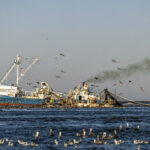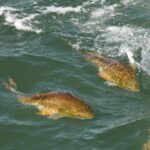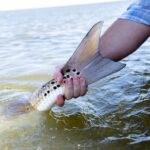
Gulf Menhaden Reduction Fishery: Bycatch Research & Useless Buffer Zones
Do you remember your driver’s test? How nervous were you when the instructor pulled out
From October 19-22, the Atlantic States Marine Fisheries Commission will virtually host its 79th Annual Meeting. You can register via the link and we suggest you carve out some time for stripers and menhaden.
Menhaden
First up on the calendar is menhaden. On Tuesday, October 20th at 9 AM, the Atlantic Menhaden Board will meet to discuss setting the Total Allowable Catch (TAC) for the menhaden fishery for 2021 and 2022. In August, the board moved forward with Ecological Based Reference Points (ERP’s). This was a groundbreaking decision that accounts for menhaden’s crucial role in the ecosystem rather than just another species for harvest. We applaud the board for moving forward with this new management approach.
ASGA and Bonefish & Tarpon Trust submitted a letter regarding setting the new TAC that was included in the supplemental meeting materials. We are in favor of a precautionary TAC that would lead to no more than a 50% probability of exceeding the ERP target for fishing mortality. This equates to a TAC of no more than 176,800 mt, which represents about an 18% reduction from the current 216,000 mt TAC and would help ensure that plenty of menhaden are left in the water for predators.
A 50% probability of success is the bare minimum that should be considered. Furthermore, there is a documented decline in Atlantic herring, which has become overfished since 2017—the baseline year used to set the ERPs.This is an important facet in ERP management because Atlantic herring are the sole prey substitute for menhaden considered in the ERP model.
If you are unable to attend, we will try to give live updates via social media on the board’s proceedings.
Striped Bass.
The Atlantic Striped Bass Management Board with convene on Wednesday, October 21 at 1:30 PM. The agenda is listed below
Without a doubt, the most important part of this meeting will be the Draft Amendment 7 Public Information Document (PID). The PID for Amendment 7 has the potential to completely alter striped bass management for the foreseeable future. A work group of commissioners established the draft PID over the summer. More info on that process can be found here and in the Fireside Chat that we hosted in September.
Notably, the PID will cover striped bass management topics like reference points, management triggers, conservation equivalency, and regional management just to name a few. The board needs your feedback on each of these issues.
Once the final PID is released, we will help with your comments by giving you our take on the various sections. It is critical that you participate in the comment process. This is where the rubber will meet the road for Amendment 7. We have one shot to get it right.
During the Addendum VI process to set 2020 regulations, we generated over a thousand comments. We need to generate ten times that number this time. We have to put the board in a position where we can not be ignored.
Final Note on Striped Bass
As you may have heard, Maryland Department of Natural Resources released the Young of the Year Index (YOY) for 2020 on Tuesday. The YOY index has been taken every year since 1954. You can read about the accuracy and methodology here. This is the chart since 1954.
The YOY for 2020 was abysmal. The mean number for spawning success is 11.5. 2020 came in at a 2.5. We will get into that in a YOY blog in the next few weeks. For now, here is our take on it. This puts an incredible importance on the 2015-year class. Those fish are right on the edge of being legal this year and most females have yet to have their first spawn. The current slot harvests fish just entering the coastal stock. We are playing Russian Roulette with the last hope for a quick rebound in the striped bass stock.
This is the main reason why ASGA advocated for a 1@35” limit for striped bass during the last addendum process. If ASMFC had gone with the proven regulation of 1@35”, these fish would have the time to help replenish the stock. However, they very well might suffer a similar fate as the 2011-year class which was overharvested before they could make an impact on spawning success.
Please look out for our blog on the YOY index for striped bass as well as updates on social media and our website on the meetings next week.

Do you remember your driver’s test? How nervous were you when the instructor pulled out

If you’ve spent any time on the water in South Florida, chances are you’ve heard

Photo Credit: Graham Tayloe Big Win for Redfish in Alabama Huge news from the Marine

Feature Photo: Carter Abramson | Simms Fishing at the Fisheries Science Symposium We have more
We rely on our members and donations to keep fighting for a sustainable tomorrow in marine conservation.
GIVE THE GIFT OF FISHERIES CONSERVATION THIS HOLIDAY SEASON. SHOP ASGA GOODS THAT FUND FISHERIES RESEARCH & ADVOCACY CAMPAIGNS
JOIN ASGA IN CALLING FOR CRITICAL MANAGEMENT ACTION AFTER YEARS OF SPAWN FAILURES & POOR MANAGEMENT.
By using this website, you agree to our use of cookies. We use cookies to provide you with a great experience and to help our website run effectively. To learn more, please review our privacy policy.